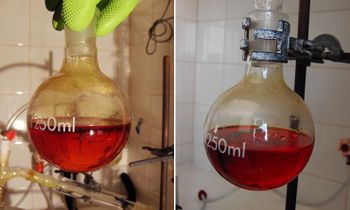Round-bottom flask
 |
This article is a stub. Please help Sciencemadness Wiki by expanding it, adding pictures, and improving existing text.
|

A round-bottom flask (also called boiling flask, round-bottomed flask, round bottom) or RBF for short, is a type of flask with spherical bottom used as laboratory glassware, mostly often for synthesis and in distillations.
Contents
[hide]General
Round-bottom flasks are spherical flasks, made of borosilicate glass (or rarer PTFE), with one or more ground glass joint necks. Usually, the main neck has a larger diameter than the other necks, though flasks with equal diameter necks exist. Size of the ground glass joint depends on the volume of the flask, for example a flask with a volume of 5 or 10 ml cannot have a 29/32 or 29/40 ground glass joint, but it can have 14/23 or 19/24. "Flasks" with the former dimensions, if they exist, are actually ground glass joint female cap plug/stoppers, are often used when working with Schlenk lines, to stopper the male joint of dropping funnels or other glassware with male joints, often when connecting it to the solvent line to collect solvent.
Round-bottom flasks with ball-and-socket joints are used in rotary evaporators, as receiving flasks, since said joints allow easy handling of flasks without the risk of freezing, and don't require greasing or sleeve joints.
Types
- Simple: Consists of a simple spherical flask with one ground glass joint.
- Multiple necks: The spherical flask has one or more ground glass joints, usually of different sizes. In case of flasks with 4 or more ground glass joint necks, the necks are positioned at equal distances from the central main neck as well as the other necks.
- Evaporating flask: Shaped like a tear, they are often used in rotary evaporators to remove or distill solvents.
- Pear-shaped: Used for small scare reactions, when working with small amounts of reagent. Pear-shaped flasks bigger than 100 ml exist, though they're rarely used. The name "heart-shaped flask" is sometimes used, as evaporating flasks are sometimes called pear-shaped due to their shape similar to that of a pear.
Round-bottom vs flat-bottom
While flat-bottom flasks, like Erlenmeyers with ground glass joints, can be used directly on hotplates without needing a heating bath/heating mantle and supporting clamps, round-bottom flasks handle vacuum much better and will ensure an even boiling, whereas flat-bottom flasks no not distribute heat evenly, with the bottom getting hot too fast compared to the top, which may increase bumping. Likewise, it's much easier to remove the content of a round-bottom flask, compared to the flat-bottom one.
Availability
Round-bottom flasks can be purchased from lab suppliers and online. Price depends on the size, type and complexity (number of necks).
Handling
Inspect the flasks for any cracks. RBFs with any defects cannot be used when working with vacuum.
To make sure they don't roll over the table and fall, RBFs should be placed on cork rings or in Berzelius flasks.